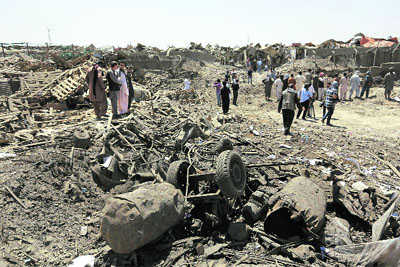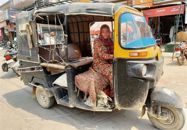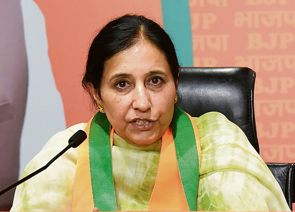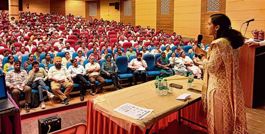
COST OF WAR: A crater caused by a truck bombing, in Kabul, Afghanistan. The world’s poorest countries have imported arms from the richest nations and wars have been fought on the territories of the poor nations. AP/PTI
S. Subramanian
THE world in which we live has long since emerged from the Dark Ages, to witness a Renaissance and an Age of Enlightenment. Reason and science, progress and modernity, should dispose us to the belief that we have come a very long way from what the philosopher Thomas Hobbes, writing in the 17th century, called “a state of nature”, which he characterised as a world of “war by all against all’, in which life is “solitary, poor, nasty, brutish, and short.” The world in which we live, surely, should be one of well-being and freedom from want. This is not the world, vouchsafed in the Book of Revelations, of the Four Horsemen of the Apocalypse — Pestilence, War, Famine, and Death: "I looked, and there before me was a white horse! Its rider… rode out as a conqueror bent on conquest… Then another horse came out… Its rider was given power to take peace from the earth and to make men slay each other…and there before me was a black horse! Its rider was holding a pair of scales in his hand. Then I heard…a voice… saying, 'A quart of wheat for a day's wages,… and do not damage the oil and the wine!’… I looked, and there before me was a pale horse! Its rider was named Death, and Hades was following close behind him.”
There are statistics on global well-being which assure us that, if we know where to look, ours is not the world foreseen in the Book of Revelations. World Bank data suggest that for the world as a whole, average annual national income (Per Capita Gross Domestic Product, or GDP for short), has increased nearly three-fold, from 5,413 Purchasing Power Parity (PPP) US dollars in 1990 to 15,064 PPP dollars in 2015. The levels of GDP per capita are particularly impressive when we focus attention on North America (an increase from 23,567 PPP dollars in 1990 to 54,680 PPP dollars in 2015) or the European Union (with corresponding figures of 14,940 and 31,677 PPP$). (For comparison, the World Bank's international poverty line for 2015 is of the order of 684 PPP$ per person per year). According to UNESCO data, in 2015 the adult (age 15+) literacy rate was 91 per cent for the world, and 99.6 per cent for the developed world. From the same data source, we find that the Infant Mortality Rate (IMR, or number of under-one mortalities per 1000 live births) was an impressively low 5.6 for the USA, and an even lower 3 for Australia in 2015. UNICEF data suggest that the maternal mortality rate (number of maternal deaths per 100,000 live births) was just 4 for Sweden, 9 for the United Kingdom, and 12 for the US in 2015. Data from the UNDP's Human Development Report indicate that in 2013 the under-5 mortality rate (number of deaths under age 5 per 1000 live births) was very small for Norway (3), Switzerland and the Netherlands (4), Australia (5), and the US (7). WHO data reveal that the adult death rate (the probability of dying between the ages of 15 and 60 years per 1000 population) was a low 88 or 89 in the European region and the region of the Americas in 2009. Correspondingly, the expectancy of life at birth in 2015 was impressively high for the region of the Americas and the European region, at 79 years.
This is the picture that emerges from looking at the right places. But what if we were to look at the wrong places? It turns out that per capita GDP rose from 1,204 PPP$ in 1990 to 5,654 PPP$ in 2015 in South Asia; from 1,640 PPP$ to 3,695 PPP$ in Sub-Saharan Africa; from 931 PPP $ to 2,181 PPP$ in the “Heavily indebted poor countries" (so that per capita GDP for North America was some 25 times that for the HIPC in 2015)! Indeed, a systematic assessment of pestilence, war, famine (or hunger) and death suggests the following:
Pestilence: According to the WHO, age-standardised mortality rate by cause (per 100,000 persons) for Africa, in 2015, was 798 from communicable diseases, 779 from non-communicable diseases, and 107 from injuries, with contrasting figures for the European region of 52, 532 and 63 respectively. The per cent of causes of death among children of less than 5 years of age due to HIV/AIDS, diarrhoea, malaria and measles was 22 per cent in the African Region, 29 per cent in the South-East Asian region, and just 5 per cent in the European and American regions.
War: Browsing through war statistics in Wikipedia yields the following doubtful reward. We find that the number of armed conflicts that have occurred in the world — rebellions, insurgencies, civil wars, wars of independence, external aggression — between 1990 and 2016 is 181. Of the 50 conflicts accounted for so far by 2016 alone, 22 have been in Africa, 13 in East and South Asia, 9 in West Asia, and 3 each in the Americas and Europe. The poorest countries of the world, which have seen the most war, have been net importers of arms — from the richest countries, which have experienced few conflicts on their own soil, preferring to conduct war on the territories of others. The civil wars in Burundi (1993-2005) and Somalia (from 1985 to the present) have each accounted for 300,000 deaths; and according to a report by the medical journal The Lancet, the excess deaths from the war waged in Iraq by the “Allied Coalition”, only till the end of 2006, numbered nearly 655,000.
Hunger: The International Food Policy Research Institute (IFPRI) puts out annual statistics on an indicator called the “Global Hunger Index” (GHI), which is an average of three distinguished headcount ratios — of those consuming food worth less than 1800 kilocalories per day, of underweight under-5 children, and under-5 mortalities. A score of 20 — 34.9 is regarded as “serious”, and one of 35-41.9 is regarded as “alarming”. It turns out that in 2016, the number of countries in the “serious” and “alarming” categories is 22 (out of a total of 182 countries), with scores ranging from 28.5 for India to 46.1 for the Central African Republic.
Death: Mortality figures for the poorer countries of the world are very different from those we have seen for the affluent North: for example, in 2015, the IMR for Afghanistan, Nigeria and the Democratic Republic of Congo was between 66.3 and 74.5; maternal mortality rates in 2015 for Western and Central Africa and Sub-Saharan Africa were 679 and 417 respectively; under-5 mortality in 2015 was 182 for Sierra Leone and 146 for the Democratic Republic of Congo; life expectancy at birth in 2015 was just 67 in the South-East Asian region, and even less, at 59 years, in Sub-Saharan Africa; and adult mortality rates in 2009 were a massive 347 for the African region and 167 for South-East Asia. So it would appear that, in large parts of the world that we inhabit, “well-being” is, after all, firmly in the grip of the Four Horsemen of the Apocalypse! An interesting philosophical question deserving examination (perhaps in a future installment) is the one of whether rectification is owed by the global North to the global South.
The author is an economist



























